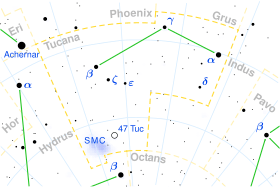Eta Tucanae
| Observation data Epoch J2000 Equinox J2000 | |
|---|---|
| Constellation | Tucana |
| Right ascension | 23h 57m 35.07819s[1] |
| Declination | −64° 17′ 53.6293″[1] |
| Apparent magnitude (V) | +5.00[2] |
| Characteristics | |
| Spectral type | A1V[2] |
| U−B color index | +0.08[3] |
| B−V color index | +0.06[3] |
| Astrometry | |
| Radial velocity (Rv) | +32.50[4] km/s |
| Proper motion (μ) | RA: +79.12[1] mas/yr Dec.: -60.80[1] mas/yr |
| Parallax (π) | 21.08 ± 0.49[1] mas |
| Distance | 155 ± 4 ly (47 ± 1 pc) |
| Absolute magnitude (MV) | 1.62[5] |
| Details | |
| Mass | 2.2[6] M☉ |
| Radius | 1.8[7] R☉ |
| Luminosity | 23[8] L☉ |
| Surface gravity (log g) | 4.31[9] cgs |
| Temperature | 9,057[8] K |
| Rotational velocity (v sin i) | 187[8] km/s |
| Other designations | |
| Database references | |
| SIMBAD | data |
Eta Tucanae (η Tuc, η Tucanae) is a star in the constellation Tucana.
Eta Tucanae is a white A-type main sequence dwarf with an apparent magnitude of +5.00. It is approximately 155 light years from Earth.[1] This is a Vega-like star that has an infrared excess. It is about 10–40 million years old and is a member of the Tucana association.[2]
References
- 1 2 3 4 5 6 Van Leeuwen, F. (2007). "Validation of the new Hipparcos reduction". Astronomy and Astrophysics. 474 (2): 653. arXiv:0708.1752. Bibcode:2007A&A...474..653V. doi:10.1051/0004-6361:20078357. Vizier catalog entry
- 1 2 3 Ehrenreich, D.; et al. (November 2010), "Deep infrared imaging of close companions to austral A- and F-type stars", Astronomy and Astrophysics, 523: A73, arXiv:1007.0002, Bibcode:2010A&A...523A..73E, doi:10.1051/0004-6361/201014763
- 1 2 Mallama, A. (2014). "Sloan Magnitudes for the Brightest Stars". The Journal of the American Association of Variable Star Observers. 42: 443. Bibcode:2014JAVSO..42..443M. Vizier catalog entry
- ↑ Kharchenko, N.V.; Scholz, R.-D.; Piskunov, A.E.; Röser, S.; Schilbach, E. (2007). "Astrophysical supplements to the ASCC-2.5: Ia. Radial velocities of ∼55000 stars and mean radial velocities of 516 Galactic open clusters and associations". Astronomische Nachrichten. 328 (9): 889. arXiv:0705.0878. Bibcode:2007AN....328..889K. doi:10.1002/asna.200710776.
- ↑ Anderson, E.; Francis, Ch. (2012). "XHIP: An extended hipparcos compilation". Astronomy Letters. 38 (5): 331. arXiv:1108.4971. Bibcode:2012AstL...38..331A. doi:10.1134/S1063773712050015. Vizier catalog entry
- ↑ Tetzlaff, N.; Neuhäuser, R.; Hohle, M. M. (2011). "A catalogue of young runaway Hipparcos stars within 3 kpc from the Sun". Monthly Notices of the Royal Astronomical Society. 410: 190. arXiv:1007.4883. Bibcode:2011MNRAS.410..190T. doi:10.1111/j.1365-2966.2010.17434.x. Vizier catalog entry
- ↑ Allende Prieto, C.; Lambert, D. L. (1999). "Fundamental parameters of nearby stars from the comparison with evolutionary calculations: Masses, radii and effective temperatures". Astronomy and Astrophysics. 352: 555. arXiv:astro-ph/9911002. Bibcode:1999A&A...352..555A. Vizier catalog entry
- 1 2 3 Zorec, J.; Royer, F. (2012). "Rotational velocities of A-type stars". Astronomy & Astrophysics. 537: A120. arXiv:1201.2052. Bibcode:2012A&A...537A.120Z. doi:10.1051/0004-6361/201117691. Vizier catalog entry
- ↑ David, Trevor J.; Hillenbrand, Lynne A. (2015). "The Ages of Early-Type Stars: Strömgren Photometric Methods Calibrated, Validated, Tested, and Applied to Hosts and Prospective Hosts of Directly Imaged Exoplanets". The Astrophysical Journal. 804 (2): 146. arXiv:1501.03154. Bibcode:2015ApJ...804..146D. doi:10.1088/0004-637X/804/2/146. Vizier catalog entry
This article is issued from
Wikipedia.
The text is licensed under Creative Commons - Attribution - Sharealike.
Additional terms may apply for the media files.
